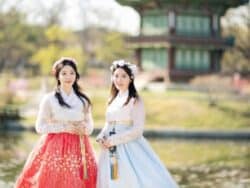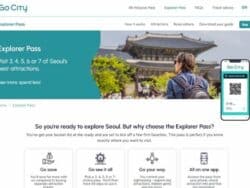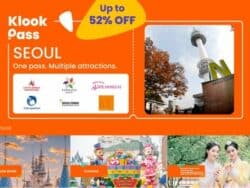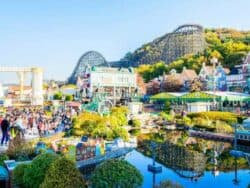📍 서울특별시 중구 세종대로 99 | 99, Sejong-daero, Jung-gu, Seoul
🚆 City Hall Station Line 1 Exit 2, or Line 2 Exit 12
🕒 09:00 – 21:00 | Last admission 1 hour before closing | Closed every Monday
₩ Adult (19 – 64): ₩1,000 ($0.7) / Group over 10 people: ₩800 ($0.6) | Free entrance for under 19 or over 65, people wearing Hanbok.
* Combination Ticket for 4 palaces (Gyeongbokgung, Changdeokgung, Changgyeonggung, Deoksugung) and Jongmyo Shrine: Adult ₩10,000, child: ₩5,000.
🌐 https://www.deoksugung.go.kr
☎️ +82 2-771-9951
✍🏻 Free entrance on a Culture Day (the last Wednesday of every month).
If you want a unique place in downtown Seoul with Korean traditional and Western touches, head to Deoksugung Palace. This is the smallest of Seoul’s five royal palaces, yet it has a lot of interesting things to see. The famed Stonewall Road around the palace, in particular, was used to feature in the famous and iconic K-drama Goblin. This post will give you all the information you need to plan your trip.
How to get to Deoksugung Palace
Address: 서울특별시 중구 세종대로 99 | 99, Sejong-daero, Jung-gu, Seoul
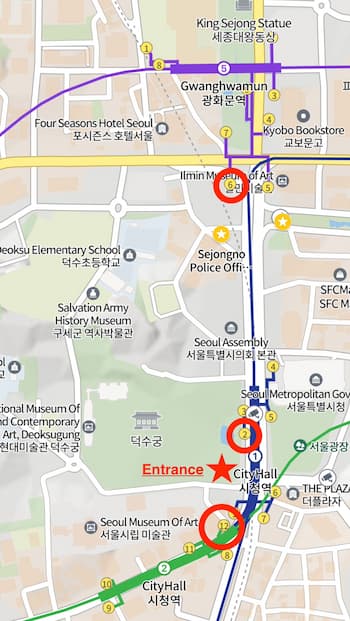
Deoksugung Palace is conveniently located in the center of Seoul and is simple to get to. However, there is no parking lot available at Deoksugung Palace, so it’s recommended to use public transportation or a taxi.
By Subway
The easy way to get there is to take the subway to City Hall Station. If you’re on Line 1, use Exit 2. If you’re on Line 2, go for Exit 12. Once you’re out, just walk straight for about a minute, and you’ll see Deoksugung Palace right before you!
And here’s a bonus tip: If you’re already at Gyeongbokgung and want to visit Deoksugung next, it’s a simple 20-minute walk – just 1km away.
By Bus
Deoksugung Palace is in the heart of Seoul, so it’s super accessible by bus. If you’re in the city, you can catch one of the many buses that pass by. Look for the Blue Bus (routes 103, 150, 401, 402, 406) or the Green Bus (routes 1711, 7016, 7022, 7019). The bus stops are located right next to City Hall station exit 2. And if you’re coming straight from Incheon Airport, buses 6005 and 6701 will take you there. Just hop on, and you’ll explore the palace in no time!
Tips for Visiting Deoksugung Palace

- There are free tours by professional guides in many languages, such as Korean, Chinese, English, and Japanese. The tour takes about 1 hour and starts in front of the General Information Board. You can visit the official website to check the schedule and arrive 30 minutes earlier to make the application.

- Book a Free Walking Tour of Deoksugung Palace and explore this historical gem with a volunteer local guide. It’s a fantastic way to dive into the palace’s rich history and culture, all guided by someone who knows it best!
- If you want to explore by yourself, you can rent the Audio Guide for 3,000 won (2.27 USD) at the ticket booth. The audio is available in English, Korean, Japanese and Chinese. Or you can use the free Deoksugung Palace audio guide here.
- It’s best to wear a hanbok when visiting if you like to take stunning photos here. Also, if you wear a hanbok, you can enter the palace for free. Check out our Hanbok renting guide.
- Otherwise, you can make it easy with the Go City Seoul Explorer Pass, Discover Seoul Pass, or Klook Seoul Pass. These passes include access to Hanbok rentals near royal palaces, Lotte World, Folk Village, N Seoul Tower, Cookin’ Nanta Show, Everland Shuttle, DMZ Tour, Nami Island, Han River Cruise, Seoul Land, Dynamic Maze, Alive Museum, and even a Seoul Pub Crawl in Hongdae.
- The Royal Palace Pass: If you plan to visit multiple palaces in Seoul, you should buy this pass. The Royal Palace Pass is KRW 10,000 (7.58 USD) and is valid for three months after purchase. With the pass, you can visit Gyeongbokgung, Changdeokgung, Changgyeonggung, Deoksugung, and Jongmyo Shrine. This pass is only available onsite at the four palaces or shrines above.

- The Changing of the Guard Ceremony at Daehanmun Gate at 11:00, 14:00, and 15:30.
About Deoksugung Palace
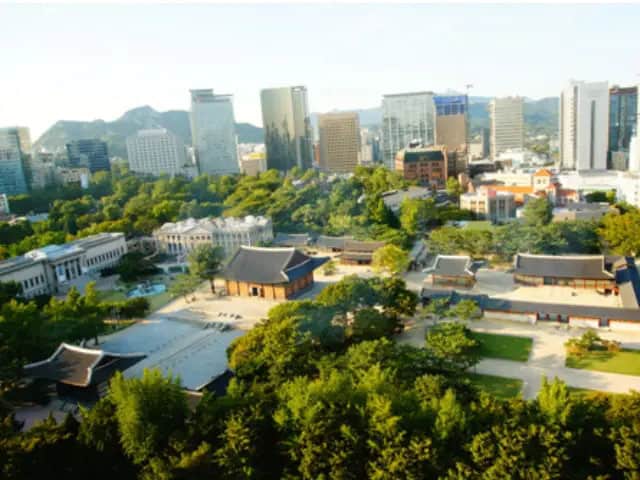
Deoksugung Palace is one of five remaining royal palaces in Seoul, most of which were constructed during the 20th century. The Palace translates as “Palace of Virtue and Longevity” in the spirit of Emperor Gojong’s wish for a long life.
Deoksugung uniquely blends traditional Korean architecture and structures with Western influences. Many people find the contrast of Western-style gardens and fountains among traditional Korean structures and palaces fascinating and a good depiction of contemporary Korea.
The stunning stone wall around the grounds of Deoksugung’s palace is well-known. Goblin and other Korean dramas have used the surrounding stone wall as a backdrop and filming location. People love to visit and take pictures there as well. When planning your trip to Seoul, don’t forget to include a stop at this stunning palace.
What to see in Deoksugung Palace
Geumcheongyo Bridge
When you step into Deoksugung, you’ll first notice Geumcheongyo Bridge. What sets this bridge apart from others in Seoul’s royal palaces is that, originally, the entire complex was designed as a private residence without a natural stream underneath. When Deoksugung became an official palace, an artificial waterway, and Geumcheongyo Bridge were constructed. Today, the waterway has been transformed into a pond that visitors can explore.
Daehanmun Gate

Daehanmun Gate is now the main gateway to Deoksugung Palace. When renovated in 1906, the gate’s name was changed from Daeanmun to Daehanmun. The gate faces east and is the only one-story entrance gate in any of Seoul’s five royal palaces.
If you want to watch a cultural spectacle, the Changing of the Guard Ceremony at Deoksugung Palace is a must-see. This captivating event takes place in front of Daehanmun Gate at three different times: 11:00, 14:00, and 15:30.
Junghwajeon Hall

Junghwajeon Hall is the main building in Deoksugung Palace. It used to be where important government matters and meetings happened. Originally two stories, it was rebuilt as a one-story structure in 1906. On the path to the hall are rectangular stones known as ‘pumgyeseoks,’ which are stone markers where military officers would line up according to their ranks on official occasions.
As you approach the hall, you’ll find mystical animals etched into the stone steps and symbolic elements such as clouds, grass, and flowers. The focal point is a throne on an elevated platform between two columns. The throne room features a wooden folding screen with designs representing the sun, moon, and mountains. This is an ideal spot to glimpse Korean architecture and culture.
Jeukjodang Hall and Junmyeongdang Hall

The Jeukjodang Hall is a significant structure within the Deoksugung Palace complex since it is where King Gwanghaegun and King Injo rose to the throne. A corridor connected it to the next building, Junmyeongdang Hall. In the Junmyeongdang Hall, Emperor Gojong received honored visitors and foreign envoys. Later, Emperor Gojong and Sunjong’s portraits were housed here.
Jeonggwanheon Pavilion
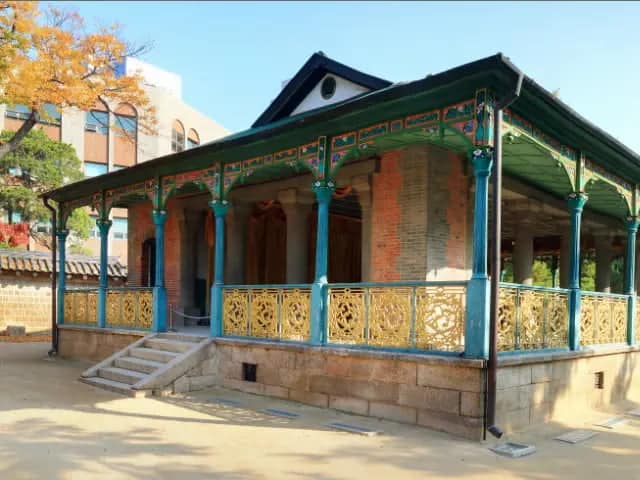
Jeonggwanheon translates as “silently watching the garden.” It was the first example of European architecture to be created in a royal palace and completed in 1900. This structure was used to host events and entertain guests.
Despite its Western architectural style, this building combines elements of Korean architecture, such as gold accents and bright flower designs. There is also a tiny garden area in front of the Pavilion with a view of the other buildings on the palace grounds, which is an excellent place to capture some lovely shots!
Seokjojoen Hall

Seokjojeon Hall, which translates to “stone house,” was one of the first western constructions in Korea. Harding, a British architect, created it. This hall, completed in 1910, has served many purposes, including housing the National Museum of Korea. However, after restoration, it reopened as the Daehan Empire History Museum in 2014.
Seokjojeon Hall’s ground floor, once used by imperial attendants, now features free exhibits on the modernization of the Daehan Empire and the palace neighborhood. You can take a guided tour of the first and second floors of Seokjojeon Hall to see how the Korean imperial family lived. Tours last 45 minutes and are available in English at 9:30 and 16:30. You can sign up on-site for free.

If you’re into art, head to the Museum of Modern and Contemporary Art (MMCA) in the West Wing of Seokjojeon. You can see the greatest in modern and contemporary Korean art here. However, to access the museum, you must pay an extra fee, which varies depending on the exhibit being shown.
Jungmyeongjeon Hall

Jungmyeongjeon Hall is a short walk from the palace grounds. When Deoksugung burned down in 1904, Jungmyeongjeon Hall became King Gojong’s main headquarters for discussing national matters. It was also part of the main palace grounds until a stone wall separated the two places. Jungmyeongjeon, like Seokjojeon, featured a modern and western architectural style. Since 2007, it has been officially included in Deoksugung. Four floors to visit highlight the history of what happened here.
Stonewall Road
The stonewall surrounding Deoksugung is a favorite spot, not just because it encloses the palace but also due to the charming walkway alongside it. Locals often enjoy this picturesque path, stretching approximately 900 meters. It becomes even more enchanting in spring and fall when flowers and foliage add to its allure. After your palace visit, stroll along the stonewall for a calming and visually pleasing experience.
Cultural Events at Deoksugung Palace
Night at Seokjojeon

Don’t miss the captivating “Night at Seokjojeon” at Deoksugung Palace, an exclusive evening program running during the fall. This unique experience includes a guided night tour of Seokjojeon, savoring Emperor Gojong’s favorite coffee and desserts at a terrace café, and the mesmerizing musical performance “Gojong – The Dream of Korea.” Priced at 26,000 KRW ($19.53) per person.

Guided by palace staff, visitors will embark on a special journey through time, exploring the stories of the Korean Empire within the walls of Deoksugung’s Seokjojeon. Receiving an overwhelming response for its biannual runs in both the first and second halves of 2023, it is anticipated that the “Night at Seokjojeon” event at Deoksugung Palace will continue in 2024. Stay tuned for updates on this enchanting experience!
Jeongdong Night Walk

Step into a time capsule at the Jeongdong Night Walk, a mesmerizing evening stroll right by Deoksugung Palace in the heart of Seoul. This isn’t just any walk; it’s a journey through the vibrant heart of modern Korean history featuring over 30 cultural hotspots, including Deoksugung and the Seoul Museum of Art. It all comes alive from 6:00 PM to 10:00 PM.
Immerse yourself in a world of night-time historical walking tours, captivating street performances, and breathtaking night scenery. And don’t forget to indulge in the delicious local cuisine! Let me keep you posted with the latest dates for this year’s event! 🗓️✨
Best time to visit Deoksugung Palace

The best time to visit Deoksugung Palace in Seoul largely depends on personal preferences and the experience you seek. But the most popular times to visit are Spring and Fall.
From March to May, spring covers the palace with beautiful cherry blossoms. These blossoms are most enchanting from late March to early April, creating a romantic atmosphere. From September to November, the palace transforms with vibrant autumn foliage in the fall, reaching its peak in late October to early November. The cool, crisp weather during this time adds to the pleasant experience.
Nearby attraction
Jeongdong Observatory

- Address: 15, Deoksugung-gil, Jung-gu, Seoul 서울특별시 중구 덕수궁길 15 (서소문동)
- Open hours: Currently open on weekends only from 9:00 – 17:30
The Jeongdong Observatory is on the 13th level of Seoul City Hall’s Seosomun building. There is a cafe inside the observatory where you may enjoy a drink while viewing the spectacular view of Deoksugung Palace from above. The view from above is stunning regardless of the season or time of year, so you’ll always capture some great shots no matter when you go!
Seoul Museum of Art
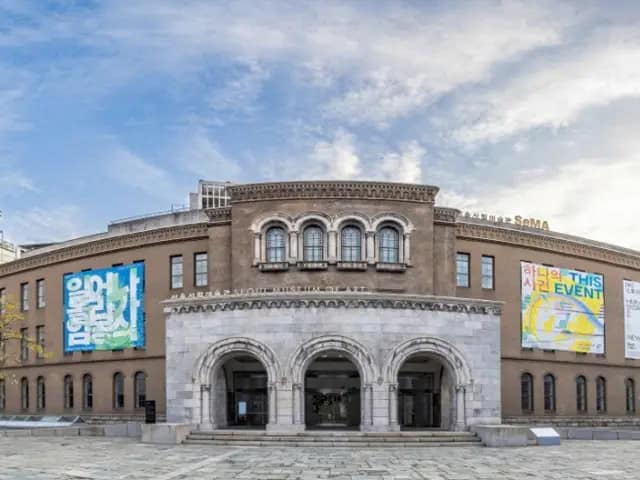
- Address: 61, Deoksugung-gil, Jung-gu, Seoul | 서울 중구 덕수굴길 61 (서소문동)
- Hours: 10:00-20:00 Tuesday to Friday | 10:00- 19:00 Saturday and Sunday| Closed on Mondays
- Phone: +82 2-2124-8800
- Website: https://sema.seoul.go.kr
- Admission: Free except for special exhibitions
You will pass the Seoul Museum of Art while strolling along Stonewall Road. If you enjoy modern art and want to understand more about Korean artists and artists, this is an excellent spot to visit after visiting Deoksugung! The museum has a variety of exhibitions and events that change regularly, so check their website to see what exhibitions are on during your visit.
Deoksugung Stonewall Walkway

- Address: 2-1, Jeongdong-gil, Jung-gu, Seoul | 서울 중구 정동길 2-1 ~ 46, Jeongdong-gil, Jung-gu, Seoul | 서울 중구 정동길 46
The Deoksugung Stonewall Walkway, known for following the stone wall of Deoksugung Palace, is a famous spot in Seoul. It’s not just a path; it’s a haven for locals seeking a peaceful break and a romantic destination for couples. The charming blend of maple trees and the historic stone walls creates a picturesque scene.
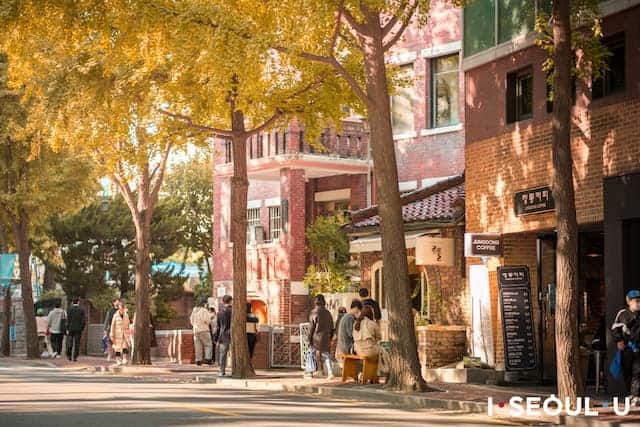
Along this path, you can also encounter old architectural gems that whisper tales of history. And don’t miss the cozy cafes dotted along the way – perfect for a relaxing pause in your journey. I highly recommend a stroll here to experience the serene beauty and rich history it offers.
Seoul City Hall

- Address: 110, Sejong-daero, Jung-gu, Seoul 서울특별시 중구 세종대로 110
- Open hours: 9:00 – 18:00 on weekdays | Closed on weekends
- Phone: +82 2-731-2120
- Admission: free
- Website: https://www.seoul.go.kr
Seoul City Hall is an environmentally friendly structure with a striking appearance inspired by traditional Korean house eaves. Government offices comprise 62% of the space, while public places for citizens comprise 38%. The most well-known feature of the structure is its vertical garden. This vertical garden spans an area the size of a soccer field and goes from the first to the seventh story, including approximately 70,000 plants of 14 different varieties.
There’s also an observation deck with sweeping views of the city and Gyeongbokgung. Furthermore, there is Seoul Plaza, which is located just in front of the city hall. This is the venue for gatherings, shows, and even an ice rink in the winter.
Other Four Main Palaces

Gyeongbokgung Palace is the largest and most visited of the five palaces. The gardens of this lovely palace have a lot to offer and can keep you busy for hours. Check out our guide to Gyeongbokgung Palace here.
Changdeokgung Palace is famous for its Secret Garden, considered gorgeous every season. This palace only allows viewing on a tour you must reserve when you arrive, and English guides are only available at certain hours.
Changgyeonggung Palace boasts a large garden and a gorgeous Japanese colonization-era greenhouse. The palace is lovely, and you can often wander the grounds alone.
Gyeonghuigung Palace is a palace that is sometimes ignored but is fantastic if you just want to examine the architecture quickly and easily on your own. Gyeonghuigung Palace is also free and a great stop if you want a bit more privacy while visiting the palace.
Top accommodations near Deoksugung Palace
Koreana Hotel
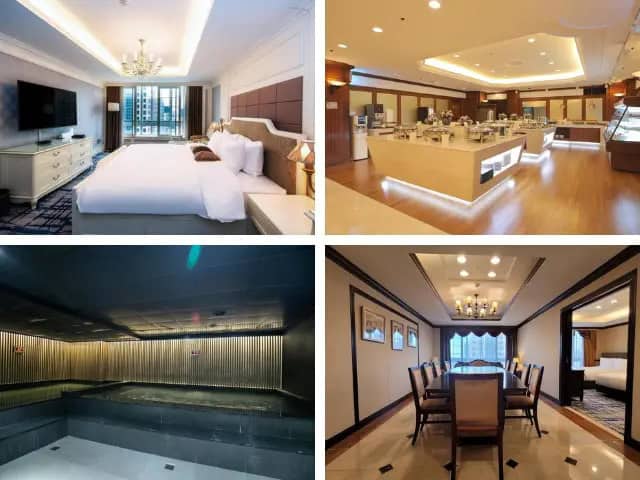
- Address: 135, Sejong-daero, Jung-Gu, 04519 Seoul
- Phone:+82 2-2171-7000
- Website:https://www.koreanahotel.com/en/
- Check-in: from 15:00
- See the best price at Agoda.com (88 USD)
This is one of the most popular choices around this area. The hotel is conveniently located 290m from Deoksugung Palace and 250m from City Hall Station, so you can easily explore the city and surrounding attractions.
The Koreana Hotel has stylish and spacious rooms with views of the Cheonggyecheon stream and the city. Each room has modern amenities such as a TV, a refrigerator, a well-stocked minibar, and tea/coffee-making facilities. The staff is nice and can assist you in four languages: English, Korean, Chinese, and Japanese.
Highlights
- 3 restaurants on-site (Chinese, Western and Japanese cuisines) and a bar
- Airport pick-up and drop-off service
- Breakfast included
- Minimarket on site
- 200m to Ilmin Museum of Art
- 550m to the Seoul Museum of Art
- 2.2km to N Seoul Tower
President Hotel

- Address: 16, Eulji-ro, Jung-Gu, 04533 Seoul
- Phone: +82 2-753-3131
- Website: https://www.hotelpresident.co.kr
- Check-in: from 15:00
- See the best price at Agoda.com (73 USD)
This hotel is in a great location. Directly over the City Hall Subway Station, with entrances directly out front. Seoul Plaza, a large grassy area with year-round entertainment, and City Hall are located across the street. The nearby Lotte Department Store and the historic Deoksugung Palace are only five minutes walk away.
The rooms here are spacious and well-equipped. They also have three restaurants and a bar on-site.
Highlights
- Free parking
- Fitness centre
- Coffee house on-site
- 400m to Deoksugung Palace
- 1.5km to Gyeongbokgung Palace
Shilla Stay Seodaemun
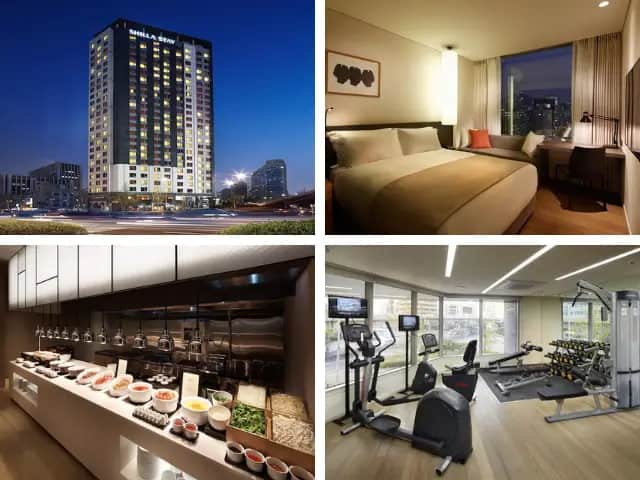
- Address: 76, Chungjeong-ro, Seodaemun-gu, Seodaemun-Gu, 03738 Seoul
- Phone: +82 2-6388-9000
- Website: https://www.shillastay.com/seodaemun
- Check-in: from 15:00
- See the best price at Agoda.com (75 USD)
The hotel is outside Seodaemun Subway Station’s Exits 7 and 8 (Line 5) and 740m from Deoksugung Palace. The rooms here are clean and have a good view of the city. They provide all the necessary facilities, such as a gym, meeting rooms, restaurants, and more. Moreover, many cute cafes are nearby with great drinks and an Instagramable backdrop.
Highlights
- Buffet breakfast
- English speaking staffs
- 350m to Dokdo Museum Seoul
- 650m to the Seoul Museum of Art
- 1.8km to Gyeongbokgung Palace
In conclusion, even though Deoksugung Palace is the smallest of Seoul’s five royal palaces, it offers special experiences you won’t find anywhere else. Come and have a look for yourself; you won’t regret it.
You may also like:
- Must-Visit 5 Grand Palaces in Seoul
- Cheongwadae (Blue House): What To See & How To Get There
- Sindangdong Hot Places: Cafes, Restaurants, Pubs 신당동
IVK’s Top Picks – Day Tours, Tickets, and Travel Activities
Seasonal Picks!😍









